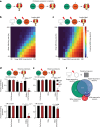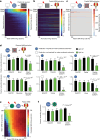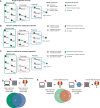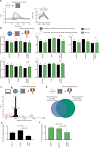A Drosophila computational brain model reveals sensorimotor processing
- PMID: 39358519
- PMCID: PMC11446845
- DOI: 10.1038/s41586-024-07763-9
A Drosophila computational brain model reveals sensorimotor processing
Abstract
The recent assembly of the adult Drosophila melanogaster central brain connectome, containing more than 125,000 neurons and 50 million synaptic connections, provides a template for examining sensory processing throughout the brain1,2. Here we create a leaky integrate-and-fire computational model of the entire Drosophila brain, on the basis of neural connectivity and neurotransmitter identity3, to study circuit properties of feeding and grooming behaviours. We show that activation of sugar-sensing or water-sensing gustatory neurons in the computational model accurately predicts neurons that respond to tastes and are required for feeding initiation4. In addition, using the model to activate neurons in the feeding region of the Drosophila brain predicts those that elicit motor neuron firing5-a testable hypothesis that we validate by optogenetic activation and behavioural studies. Activating different classes of gustatory neurons in the model makes accurate predictions of how several taste modalities interact, providing circuit-level insight into aversive and appetitive taste processing. Additionally, we applied this model to mechanosensory circuits and found that computational activation of mechanosensory neurons predicts activation of a small set of neurons comprising the antennal grooming circuit, and accurately describes the circuit response upon activation of different mechanosensory subtypes6-10. Our results demonstrate that modelling brain circuits using only synapse-level connectivity and predicted neurotransmitter identity generates experimentally testable hypotheses and can describe complete sensorimotor transformations.
© 2024. The Author(s).
Conflict of interest statement
P.K.S. is an employee and equity holder of Eon Systems. The other authors declare no competing interests.
Figures









Update of
-
A leaky integrate-and-fire computational model based on the connectome of the entire adult Drosophila brain reveals insights into sensorimotor processing.bioRxiv [Preprint]. 2023 May 2:2023.05.02.539144. doi: 10.1101/2023.05.02.539144. bioRxiv. 2023. Update in: Nature. 2024 Oct;634(8032):210-219. doi: 10.1038/s41586-024-07763-9. PMID: 37205514 Free PMC article. Updated. Preprint.
References
MeSH terms
Substances
Grants and funding
LinkOut - more resources
Full Text Sources
Molecular Biology Databases

